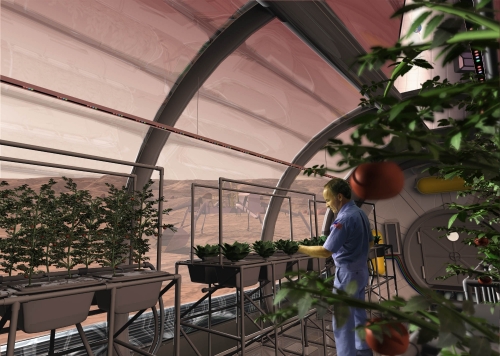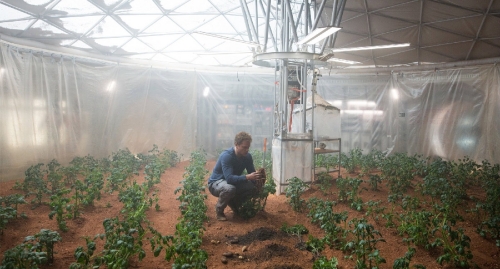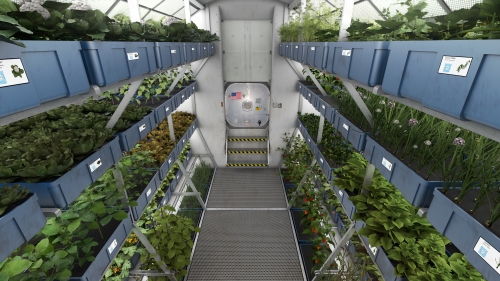Because Centauri Dreams focuses on the outer system and beyond, I haven’t had much to say about Mars, knowing how many good sites there are that cover developments there. But today’s post is timely not only because of recent depictions of Mars in film but also because long-term sustainability is critical to a lasting human presence off-world. Dr. Ioannis Kokkinidis is a native of Piraeus, Greece. He graduated with a Master of Science in Agricultural Engineering from the Department of Natural Resources Management and Agricultural Engineering of the Agricultural University of Athens. He holds a Mastère Spécialisé Systèmes d’informations localisées pour l’aménagement des territoires (SILAT) from AgroParisTech and AgroMontpellier and a PhD in Geospatial and Environmental Analysis from Virginia Tech. Have a look now at what we could do to sustain a human settlement on another world.
By Ioannis Kokkinidis

I believe most readers of this blog have seen Ridley Scott’s The Martian and perhaps have even read Andy Weir’s book. Our hero Mark Watney is stranded on Mars and has to overcome a series of crises in order to survive, including growing food. Entertainment aside, the question of how could we grow crops on other worlds is a serious one. As an agronomist, a practitioner of the scientific discipline that conducts analysis and experiments so as to offer advice to farmers, I offer here my take on the subject.
The issue of growing food on other worlds seems to be generally neglected in science fiction. It tends to be brushed over through the use of replicators, miraculously processed food that turns into a scrumptious meal with a few drops of water or other similar plot devices. Until these devices are invented it is better to speculate using existing technology. The majority of the suburban and urban populations are not aware of modern agricultural practices, having a mental image of a rural utopia that reflects decades or centuries past.
Also, farming practices in each country tend to reflect its socioeconomic conditions and level of development: the best method to grow food in the confined and limited space of a colony is often not the one practiced by farms near where you live. For this article I will give a special emphasis on Mars, because our knowledge of the planet is better than that of other heavenly bodies and because of its relative suitability compared to other worlds. This article is divided into two parts dealing with plant and animal production.
Plant Production
Plants require some 30 or so elements to grow. C, H, O, N, P and K are required in large quantities and are called macronutrients, Fe is an intermediate case and the rest are called micronutrients, required in minuscule quantities. Carbon is absorbed from the atmosphere in the form of CO2. Hydrogen is absorbed through the roots in the form of water. Oxygen enters through CO2 and H2O, while the rest of the elements are absorbed through the roots dissolved in the liquid solution. A common misconception about plants is that soil is necessary for their growth: it is not. What is necessary is a liquid solution containing the necessary elements to grow. The practice of growing plants in a soil-less medium is known as hydroponics and was the subject of my undergraduate thesis, which I conducted in Portugal as an Erasmus student. The very specific case where instead of a medium the root is suspended in midair, with the solution sprayed to the root, is called aeroponics.
Hydroponics dates to plant nutrition experiments in the late 19th century. The first major applications appeared during WWII when it was used to grow fresh food by the United States armed forces in the Pacific for garrisons in bare islands that were too isolated for effective resupply. Commercially it was first used in the Netherlands during the 1960’s in greenhouses, where after decades of using the same soil there were too many disease vectors for use. Over the decades it has become a relatively popular method to grow crops in greenhouses, preferably in places that are densely populated and have significant available capital. While all crops can be grown hydroponically, commercially it is limited to high value crops such as vegetables and flowers: Field crops receive free ecosystem services from the environment; in a hydroponic greenhouse we need to provide and/or supplement them artificially.
Plants convert radiation into biomass through photosynthesis. In lower plants such as blue green algae this biomass is in the form of undifferentiated cells. In higher plants there are differentiated organs such as tubers, fruits, stems and leafs. While algae is consumed whole after treatment, we often consume parts of plants, the specific part depending on the species.
Furthermore, there is no such thing as a superplant able to provide the entire needs of human nutrition on its own. We will need to grow a mix of species to provide the various needs of the colonists. A major problem though is that we do not know what the actual nutritional needs of the colonists will be. An office worker on Earth needs 2000-2500 calories per day; a manual laborer can easily consume over 5000. We do not know what the effect of lower gravity is in caloric consumption or the relative requirement on each food component. However, there have been various studies proposing crops mixes for future colonies.
I envision the future Mars plant growth facility as a greenhouse. Since Martian surface pressure is very close to a vacuum, this greenhouse will need to be a pressure vessel. The closest thing yet constructed to a high transmittance pressure vessel is the ISS Cupola. The alternative option is to build a completely enclosed facility with artificial illumination. I am more in favor of a facility with windows, as the inside of a greenhouse is a very corrosive environment and in my opinion it is better to have the option of the sun than to be completely reliant on artificial light sources. That being said, at Mars levels light intensity is lower than that of Earth on clear days, though pretty similar to cloudy days in Northern Europe. In Northern Europe the lack of solar illumination is compensated through supplementary artificial lighting. In my native Greece light intensity is such that farmers will actually put stucco on their greenhouse’s covering material in late spring so as to reduce illumination and the solar heating it causes. This is unlikely to be necessary on Mars.

Image: An artist concept depicts a greenhouse on the surface of Mars. Credit: NASA.
Cover materials for greenhouses on Earth tend to fall into three categories: PET, glass and clear PVC. PET (polyethylene terephthalate) is the most popular material because of its low cost and the light greenhouse structure it requires. It comes in various quality levels, ranging from a thin flexible material that lasts only one season until it is yellowed by UV radiation to relatively thick panels that are rated to last 10 years and in practice can last a bit longer. PET is susceptible to yellowing due to UV radiation and is completely clear to IR radiation. Glass is material that is bristle, easy to break but is known to last for centuries so long it is cleaned. Due to its fragility it requires a heavier structure greenhouse. Clear PVC (polyvinyl chloride) combines the lightness of PET with the longevity of glass. Unfortunately it is a very expensive material, making its uses on Earth rather rare. While I am unaware of any experiment to test long term survival of greenhouse cover material under simulated Martian conditions, my educated guess would be that clear PVC would be the best option for a Martian cover material.
The inside of a high end modern greenhouse contains quite a bit of machinery. Artificial lighting has been mentioned, which will be necessary not only for increasing radiation but also in order to control day length: many temperate species will not set flowers and fruit unless a specific day or night length is met. This phenomenon is known as photoperiodism. On the flip side, the greenhouse will also require a shade to extend night length. In order to reduce heat losses during the night we will most likely need a thermal blanket.
Now in Athens from March on, on a sunny day the temperature inside a greenhouse can reach 40° C. This is not a tolerable temperature for most plants, which is why we keep the doors and windows open on a greenhouse from 10-11 am up to sunset. On Mars of course that is impossible, so should this problem arise we will need a system to remove heat during the day.
We will also need a system to add heat during the night, which even on the Martian equator in the summer can be lower than Earth’s Polar Regions. While on Earth we can rely on ambient air to introduce the CO2 which is removed by the plants, on Mars we will need to provide it. A greenhouse full of mature plants can assimilate the entirety of its atmospheric CO2 within a couple of hours from sunrise. Putting CO2 in excess of atmospheric concentration is a known method to accelerate the life cycle and increase yield in plants, called carbon fertilization.
Usually CO2 is pumped to the 1500 ppm level around sunrise, and the plants will often assimilate this by noon. Since workers often need to enter the greenhouse to work they will do so around the time CO2 drops below ambient concentration so as to bring new atmospheric CO2 in the facility. The Martian atmosphere is fortunately 96% CO2, however higher plants do not usually tolerate more than 4% concentration. Algae can survive up to 70% concentration, which is why it has been used for carbon sequestration in power plants on earth. CO can also be a problem for workers though not for the plants; they can oxidize it to CO2 and assimilate it. In general plants act as water pumps, carrying water from their roots and releasing it in their leaves. On earth we lower humidity by exchanging air, for Mars we will need to do so through machinery. We will need, though, pumps of the mechanical kind to circulate the irrigation water.

Image: From The Martian, astronaut Mark Watney (Matt Damon) works inside a flourishing greenhouse. Credit: Twentieth Century Fox Film Corporation.
Over the last few decades agronomists and farmers have tested a variety of substrates for hydroponic use and have almost always found the material suitable. There is no reason to believe Martian regolith will not be found suitable as substrate, but it would be better for the first colonists to also bring from Earth material proven to work, such as rockwool or cocopeat. While we’ll have a few plant rows working with the proven material, we will have a few experimental rows trying to discover the best methods for the regolith.
As mentioned, hydroponics plants require a nutrient solution to provide their needs. There are two types of nutrient systems available: open loop (also known as run to waste) where the solution is dumped after it passes once through the row, and closed loop, which still dumps about 20% of the solution after loop. Although we will most likely require a N fertilizer production facility anyway, since we will be dealing with limited resources, it is better to adopt a closed loop system despite the issues this creates with plant protection. In a hydroponic greenhouse the solution for each of the elements is produced in large vats where the worker mixes each fertilizer with water. The automation pumps each solution in a new vat where it is mixed to contain the element mixture we wish and pH is regulated using acid or base. Then it is sent to each row for plants to use. Plants selectively assimilate each element depending on the soil and water pH; often element deficiencies are caused not due to lack of the element in the solution but by the inability to assimilate it at the solution’s pH or competition with other elements.
Another phenomenon typical in regions with bad quality water such as Cyprus is precipitation of the micronutrients as a sediment that can block the water emitters. Future Mark Watneys will have their day full just trying to bring their crop into production.
Another issue that future Mark Watneys will need to face is plant protection. Crops on earth get attacked by a variety of pests and diseases. Much as we can try to keep an aseptic environment on Mars, this is likely to happen eventually. We have no idea what the interaction between potential indigenous Martian lifeforms and our plants could be. What we do know, though, is that it is very likely we will bring pests from Earth; already Scott Kelly had to combat a mold on the Veggie experiment on the ISS. By controlling humidity and temperature we can control the growth of pests. However, for major infestations we will likely need to use chemicals and this raises all sort of issues. For one thing we are talking about complicated molecules which we will either need to ship from Earth or synthesize locally. Also, we will need to make sure that they do not enter the air of the human habitat. The best line of defense, though, is polyculture, growing a variety of crops. If one particular crop fails, there will be food from the rest.
Photosynthesis is not the only way to grow food; we can grow calories from decomposition of plant material. Pleurotus mushrooms are an easy way to turn hay into high quality nutrition. All that is required is hay and a dark room without any sunlight. The hay stack (which could be the stem of the plants grown) is inoculated with mushroom spores, placed in a cubic plastic tarp with slits and we harvest every week the growth coming out of the slits. In the end we have both high quality nutrition and a material which can be used for compost at the mushroom’s roots. Soil compost, which we can also create with other biological materials in the habitat will help detoxify soil and thus move towards soil based agriculture on Mars.

Image: NASA plans to grow food on future spacecraft and on other planets as a food supplement for astronauts. Fresh food, such as vegetables, provide essential vitamins and nutrients that will help enable sustainable deep space pioneering. Credits: NASA.
Animal production
A completely vegan diet cannot easily provide all the necessary nutrients for survival in the long term. While at first we can expect animal derived products to arrive with resupply missions, in the long term we will need to engage in animal production to meet the needs of the colony. Meat is an integral part of the Western diet; however, the availability of cheap food mostly reflects the large grazing ground of the US West or the Argentinian Pampas and the policies of the EU Common Agricultural Policy. Growing animals off Earth will mean adopting the model of the Concentrated Animal Feeding Operation (CAFO) rather than low intensity pastoral agriculture.
The most important number in a CAFO is the feed conversion ratio (FCR). It is defined as the quantity of animal feed required to produce one kilogram of body mass. It varies by species, facility, feed composition, climate, age of the animal and production facility. Wikipedia has an interesting article on the subject. FCR ranges from under 2 for crickets, tilapia and some chicken facilities, around 3 for pigs and rabbits, and at least 4 for sheep and cattle.
Now, to achieve these high numbers requires optimized genetic stock, optimized feed and optimized environmental conditions. Modern efficient chicken farms require the use of high yield chicken hybrids that are provided as week old hatchlings to the CAFO. There they are kept in temperature controlled facilities, often in cages with 6 animals per cage. Feed is constituted of high yield grains which must meet specific food group mixture ratios and often includes antibiotics in sub-therapeutic concentrations so as to increase FCR. After 7-8 weeks, when the animals are immature sexually but have reached the expected weight they are harvested and sent to the slaughterhouse.
Losses of 5-10% of the original animal population are typical. Simply put, it requires a very large infrastructure with large breeding flocks so as to minimize the possibility of incest (and the drop in FCR it brings) just to provide these hatchlings. Another thing to note is that we do not eat whole animals or fishes, only part of them. Typically the commercial cuts of the animal are in the order of 50-55% of the body mass. In other words animal production is very inefficient. However, there are a few advantages to animal production. For one thing, we do not eat the entirety of the cultivated plant. Traditionally animals consume first what people do not.
Assuming a Harvest Index of 1, typical for small grains, producing 1 kg of grains will also produce 1 kg of above ground biomass, mostly the plant stem. With a feed conversion ratio of 3 this will convert to 333 g of animal. With a commercial cut ratio of 51% this means that 170 grams of meat can be produced along with 1 kg of grains. In practice an FCR of 3 is unrealistic for any animal only fed on hay and we are likely to lose animals during production. Still, we can presume the possibility of a diet composed of 10% meat by weight in the long term of the colony without significant dedicated plant growth for feed.
If we wish to have 50% of meat in our diet by Mars-grown animals, this means that with an FCR of 3 and an edible weight ratio of 0.5 and assuming that the stem is not used for the feed, we will require 3.5 times the growth area in the farm than for a 100% vegan diet. This is on top of the necessary veterinary support for the animals or the need to manage animal wastes of all kinds. Furthermore, while we can select plant varieties that are parthenocarpic and/or self-pollinated, animals only reproduce sexually, which means that we will need to maintain a flock of sufficient genetic diversity.
Conclusion
This essay has tried to deal with some of the issues that come with growing food away from earth in a gravity environment, with an emphasis on Mars, from the perspective of an agronomist. Several of the concepts can be used in other worlds too, though it will require coming up with sources of carbon dioxide and photosynthetic radiation which are available on Mars. The MIT study of the Mars One concept mission came to the conclusion that the space allocated in the concept (80 m2 per colonist) was insufficient to provide enough calories for the colonists, while increasing to a more realistic 250 m2 led to oxygen poisoning around the time the plants were in full bloom. Bas Lansdorp replied that his plan was to use an oxygen concentrator to remove the excess oxygen from the growth facility.
There have been comments that the model that MIT used to calculate the production of oxygen overestimated how much is actually produced. As an agronomist, though, I am inclined to believe that even if that particular model has bugs, the consumption of the entire CO2 of the habitat in a day by photosynthesis in a greenhouse housing plants in the full growth stage is consistent with earth behavior of greenhouses. With this article I try to highlight for potential planners, engineers and enthusiasts the kind of issues that will realistically be encountered when designing a food growth system for a small closed colony.



Thinking about the innovative comments on algae by david lewis, joe g, ole burde, alex tolley et al.:
Cyanobacteria gardening certainly has its benefits, especially at the start of the gardening cycle, when conditions are too harsh for higher plants. We could add cyanobacteria’s nitrogen fixation to the list of benefits, as an important kickstart for garden biology.
Notably, Verseux et al. have recently explored cyanobacteria’s potential role for bioregenerative lifesupport systems (BLSS), in some depth, in “Sustainable life support on Mars – the potential roles of cyanobacteria”. This seems an important avenue of research.
Many thanks for the quantitative article and creative discussion.
Interesting article on Martian soils and the potential for farming on Mars.
Yes very interesting article , well written and with “feet on the ground” !